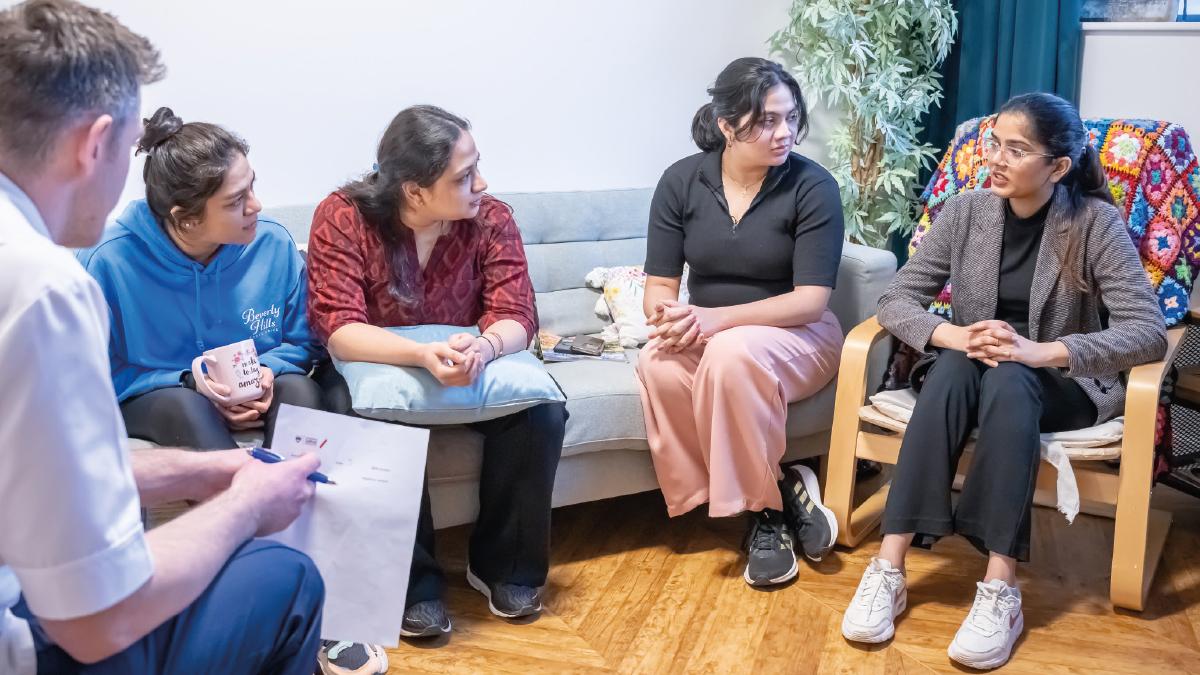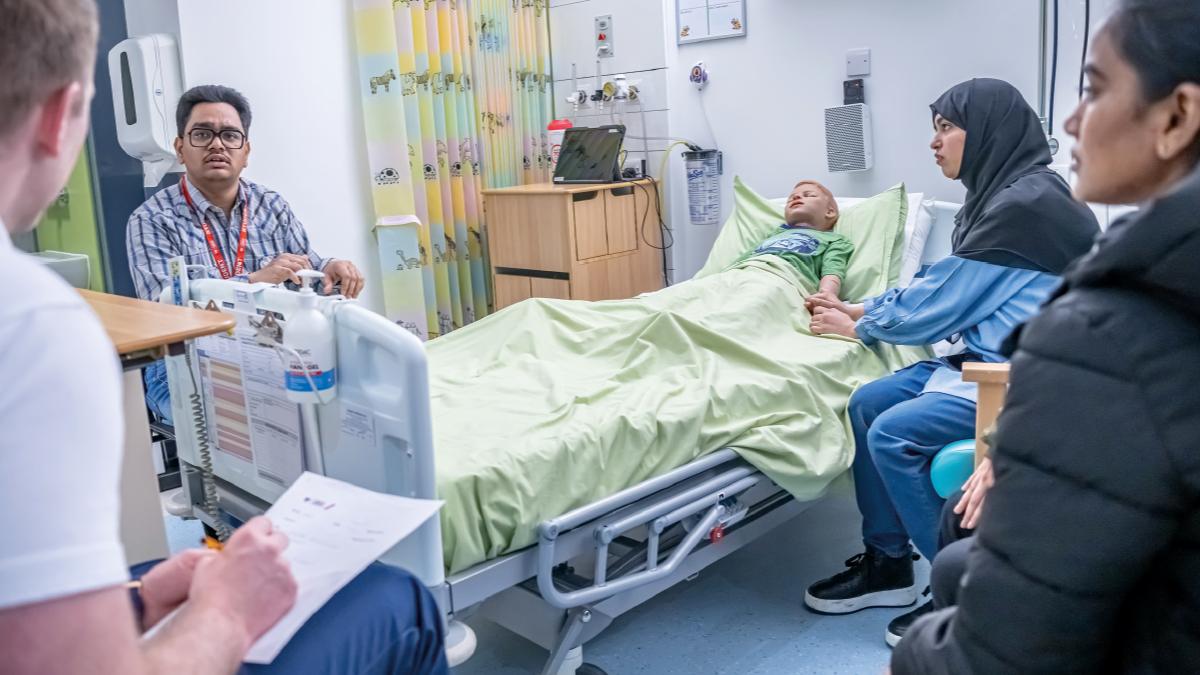Tackling health inequalities is vital to improving access to care – and new approaches utilising simulation-based learning are ensuring physiotherapist learners embed a new approach from the start. Nina Romain finds out more about this new immersive learning method
Tackling health inequalities by training for the real thing
Simulated practice learning (SPL) offers considerable potential as an evidence-based adjunct or substitute for existing clinical practice-based learning (PBL). SPL is an educational approach which allows interactive and immersive activity by recreating all or part of the clinical experience.
Actor role players, human simulated patients, human-like computer-controlled mannequins, virtual reality (VR), and other methods are used to help replicate suitably realistic clinical scenarios, so that specific learning outcomes can be achieved.
SPL provides a valuable opportunity for learners to prepare for professional practice. The advantages include offering standardised learning, so that all learners are offered similar educational opportunities and exposure for professional practice preparation (PPP). An example would be an intensive care unit.
Another advantage is supporting learner preparation before clinical PBL using adjunctive SPL and enhancing safety in High-Acuity Low-Occurrence (HALO) scenarios (those that are less common but important, such as assessment of red flags). A final benefit of SPL is that learners can prepare for professional practice where practice-based learning capacity is limited, for example in paediatrics.
The University of Salford’s simulation suites offer pioneering scenarios for its physio learners and are an example of the move towards increasing access to simulation as a modality within physiotherapy. The suites provide effective and immersive physio training, by recreating scenarios involving realistic, authentic environments and interactions for their learner physiotherapists.
Confident in communication
Within these environments, physiotherapy learners can engage in interactions with simulated ‘patients’ who represent groups facing health inequalities, who are more likely to experience challenging access to care. These groups include people with visual and hearing impairments, people with a mental illness, those with poor past health experiences, neurodiversity and language challenges.
The University of Salford philosophy behind simulation-based education is that they believe non- technical skills or ‘human factors’ are vital. These are the cognitive and interpersonal skills which underpin clinical competence, including decision-making and situational awareness, communication, teamwork and leadership skills.
The university wanted all learners to have confidence in their communication skills. This led to the development of the Simulation-Based Learning (SBL)-enhanced communications scenarios to give the learners experience before they went on placement. The learners receive training that will develop their performance in a safe environment, followed by a debrief.
The university’s scenarios enhance non-technical skills through simulation. An example involves the learners practising taking a subjective assessment from someone roleplaying a patient who is communicating using Makaton (a communication tool with speech, signs, and symbols to enable people with disabilities or learning disabilities to communicate). Another teaching exercise involved working with a ‘patient’ with a hearing and visual impairment.
The university’s approach to simulation-based education focusses on providing realistic learning environments consisting of several hospital wards complete with mannequin ‘patients’ that can be used for a range of scenarios. These can be a three-bedded adult ward, a two-bedded children’s ward, two side rooms, a treatment room, a day room and bathrooms.
Immersive environments
The suite also has beds, cots, chairs, patient lockers and all clinical equipment such as needles, syringes and fluid-giving sets sourced from NHS suppliers. To create an even greater sense of reality, each bed space has simulated oxygen and suction, patient monitors, nurse call buttons, emergency buzzers, name boards and bed lights.
A further space within the simulation suite is designed as a replica of a flat, with a living area, two bedrooms, bathroom, and kitchen, to create a realistic home environment for health and social care learners to practice home visits and assessments.
There are also two immersive interactive rooms, which can simulate a variety of locations using immersive 360 video to represent the back of an ambulance, a nightclub, a prison cell or a busy motorway. The Salford University learners also wear their work uniforms in the simulated environments so they can embed professionalism while being trained.
This level of realistic medical detail in the simulation suite provides health and social care learners with their first taste of responding to patients’ needs in a range of scenarios. It also prepares them thoroughly for the real-world placements that are a critical part of their study programme, in complex situations, so they can put themselves in the patients’ shoes.
The scenarios enable the learners to experience realistic issues with digital technology and telehealth, such as Wi-Fi problems, or ‘patients’ not having a working webcam. The learners then need to overcome challenges and problem-solve on the spot. They engage with a debrief after the exercises and develop action plans for future practice.
The learners work in two immersive interactive rooms, which can simulate a variety of locations using immersive 360 video to represent the back of an ambulance, a nightclub, a prison cell or a busy motorway
The scenarios are vital, as they let the learners work with and become familiar with working with different ‘patients’, for example, those with visual or hearing impairments. In these scenarios some of the students were trained to take on the roles of simulated ‘patients’ wearing noise-cancelling headphones and vision-impairing goggles to ensure they can’t hear or see their peers, who had to work out how to communicate effectively with them.
Addressing health inequalities
Dr Gill Rawlinson, director of allied and public health at the University of Salford, says: ‘Simulation is a fantastic teaching tool, which develops learners’ communication skills and gives them time to experience, practice and reflect on challenging communication scenarios in a safe space.’
‘We know, all too well, that many marginalised groups struggle with accessing health services and these scenarios help physiotherapy learners to support them.
The SBL-enhanced communications scenarios are enormously helpful in developing important skills for real world situations, such as working with interpreters and engaging in non-verbal communication methods. It’s a gamechanger.
Helen Sharma, head of practice at the CSP, says: ‘Addressing health inequalities now must be a central part of our practice to optimise patient care and it is now a requirement to meet HCPC standards. The University of Salford is innovating to prepare the future workforce for this challenge, and we encourage all members to think about what steps they can take.’
Theory into practice
The complexity of communication scenarios can also be increased. An example is where students need to gain information about a paediatric ‘patient’ by speaking to the ‘patient’s non-English speaking mother via an ‘interpreter’. This scenario enables learners to practice and develop the skill of working with an interpreter to accurately transmit information and assess a patient.
Meanwhile, other learners can watch the exercises via a livestream, a practice known as ‘vicarious learning’, which involves everyone observing and learning together. On a typical simulation day, learners will undertake five scenarios. The simulation sessions also add complexity and distractions in the environments to challenge the learners as they develop, so they are ready for challenging situations in their working lives.
University of Salford clinical skills tutor in physiotherapy Nikita Mascarenhas said the learners said that they were grateful the SBL was carried out before placement, as it gave them the chance to make mistakes in a safe environment, before being in the workforce.
Nikita says: ‘Our SPL shows all people are different, so you learn how to get the best out of each patient, and learn about the different types of health system, both inpatients and outpatients. The learners gain experience and put the theory into practice to give patient-centred care each time, and say it has been really rewarding, as they feel safe and empowered when they deal with this on the wards.’
CSP education adviser Sundeep Watkins adds: ‘The use of realistic immersive experiences for key core skill building is a really productive and effective use of simulation-based education.’
‘It is also great to see an example which develops learner confidence and competence around issues that can affect health inequality for patients accessing physiotherapy services.’
First-year learner Alex Mason-Reynolds, studying part-time at Salford University for a BSc in physiotherapy, describes the simulation-based sessions as ‘the best way to prepare for real-world scenarios.’
Alex continues: ‘The simulation sessions utilise model homes, hospital wards, and office settings to mirror the environments we will encounter daily. These simulations allow us to face realistic challenges, such as working with interpreters, communicating with members of the disabled community, and navigating virtual physiotherapy sessions. Hands-on experience in these simulated environments elevates our learning to a new level and equips us with the practical knowledge and skills we will need throughout our careers.’
Find Out More
Number of subscribers: 1

![Health inequities simulation feature [Photos: University of Salford]](/sites/default/files/styles/unstyled_max_width_1200px/public/media-image/2024-08/43_47_sep_2024_simulation_feature_1200x675px_02.jpg?itok=OapYfG9h)

